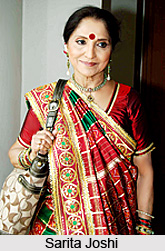 Pravin Joshi, born in 1936, was a young enthusiastic actor in Bombay. He attracted attention at Bharatiya Vidya Bhavan`s one-act competitions in the mid-1950s. Joining the prosperous Indian National Theatre (INT) under Damu Jhaveri, he acted and directed IN their most popular adaptations like Mogarana sap in `Snake in the Jasmine` in 1963, from Frederick Knott`s Dial M for Murder, Manju Manju in 1965, from Jean Kens Mary Mary, Chandarvo i.e. `Colourful Canopy` in 1966, from Merry-go-round by Albert Maitz and George Sklar, Santu rangili i.e. `Enchanting Santu` in 1974, from Shaw`s Pygmalion, and Mosam chhalake i.e. `Pleasant Times` in 1978, from Bernard Slade`s Same Time Next Year. Pravin successfully directed two original Gujarati plays, Ramji Vania`s Moti veranan chokman i.e. `Pearls Scattered in the Yard` in 1969 and Madhu Rye`s Kumarni agasi translated as The Terrace in 1972. In this play he acted alongside Sarita Joshi. She was a fine, sensitive actress, whom he later married. Pravin Joshi had a keen sense of space on stage, set design, lighting, and use of body and voice, and knew the pulse of the middle and upper middle-class Gujaratis of Bombay and urban Gujarat. As an actor-manager, he is considered a symbol of commercial Gujarati theatre in the 1960s and 1970s, along with Kami Madia. His untimely accidental death in 1980 took away a sensible theatre person.
Pravin Joshi, born in 1936, was a young enthusiastic actor in Bombay. He attracted attention at Bharatiya Vidya Bhavan`s one-act competitions in the mid-1950s. Joining the prosperous Indian National Theatre (INT) under Damu Jhaveri, he acted and directed IN their most popular adaptations like Mogarana sap in `Snake in the Jasmine` in 1963, from Frederick Knott`s Dial M for Murder, Manju Manju in 1965, from Jean Kens Mary Mary, Chandarvo i.e. `Colourful Canopy` in 1966, from Merry-go-round by Albert Maitz and George Sklar, Santu rangili i.e. `Enchanting Santu` in 1974, from Shaw`s Pygmalion, and Mosam chhalake i.e. `Pleasant Times` in 1978, from Bernard Slade`s Same Time Next Year. Pravin successfully directed two original Gujarati plays, Ramji Vania`s Moti veranan chokman i.e. `Pearls Scattered in the Yard` in 1969 and Madhu Rye`s Kumarni agasi translated as The Terrace in 1972. In this play he acted alongside Sarita Joshi. She was a fine, sensitive actress, whom he later married. Pravin Joshi had a keen sense of space on stage, set design, lighting, and use of body and voice, and knew the pulse of the middle and upper middle-class Gujaratis of Bombay and urban Gujarat. As an actor-manager, he is considered a symbol of commercial Gujarati theatre in the 1960s and 1970s, along with Kami Madia. His untimely accidental death in 1980 took away a sensible theatre person.
Sarita subsequently founded and directed the Pravin Joshi Theatre in 1983. Born in 1941 as Sarita Bhonsle in Pune, Maharashtra, she had joined the New Laxmikant Company in Vadodara at the age of 7. Before the INT, she gained experience in professional theatre with the Khatao Alfred Company. She has starred in over 150 productions, the most successful of which have been Adi Marzban`s Balwantni baby i.e. `Balwant`s Baby` and Santu rangili, which ran for 500 shows. In the 1970s, she entered non-commercial theatre by directing and acting in a Gujarati adaptation of Badal Sircar`s Evam Indrajit, and has also performed in award-winning Gujarati movies.




















